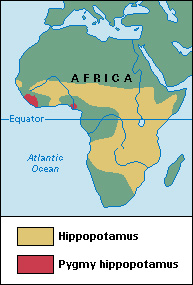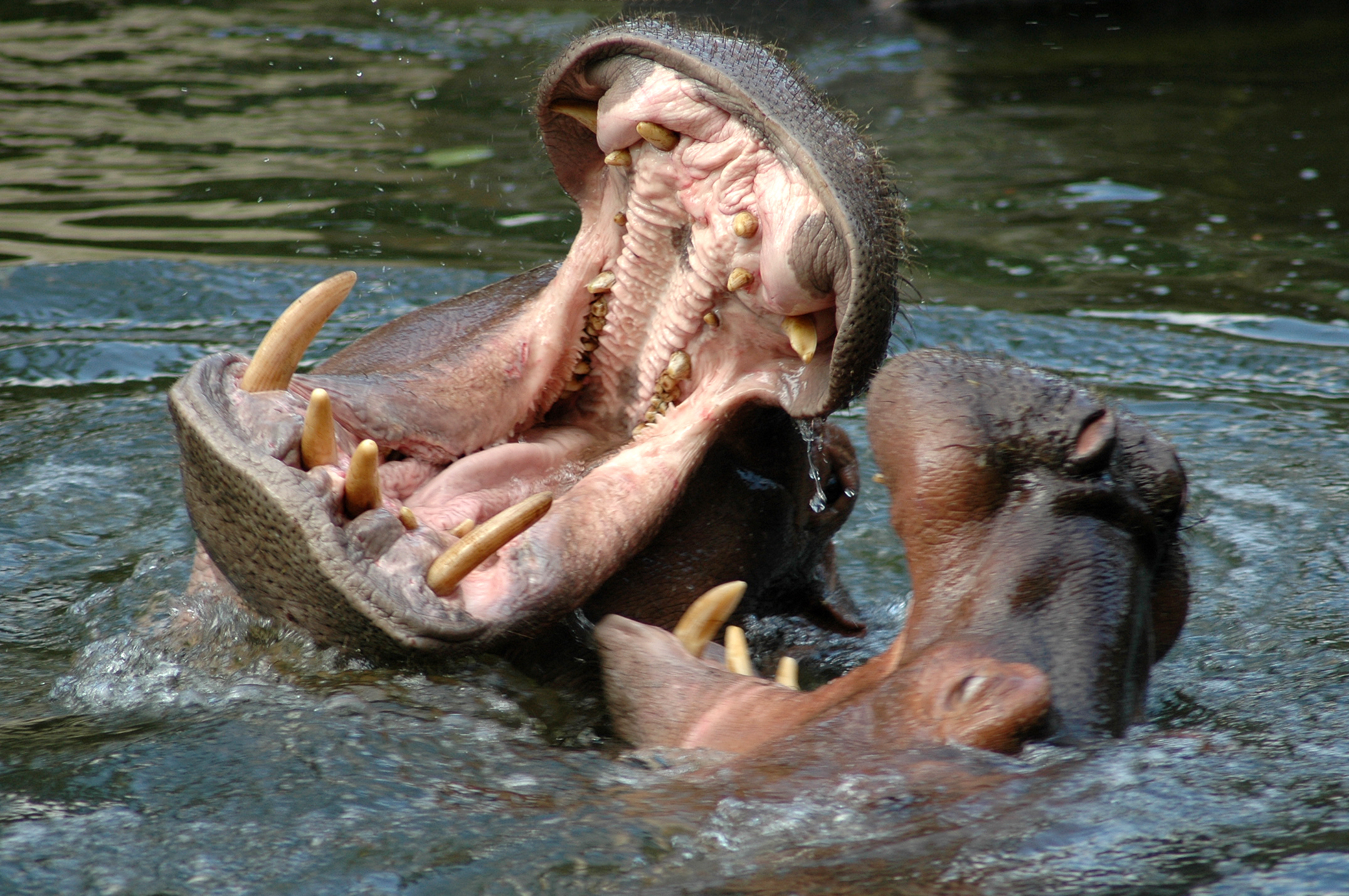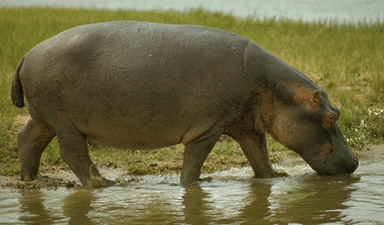Hippopotamus, << `hihp` uh POT uh muhs, >> is the third largest animal that lives on land. Only the elephant and rhinoceros are larger. A large, wild river hippopotamus may weigh as much as 5,800 pounds (2,630 kilograms).

Hippopotamuses live in central, southern, and western Africa. They live close to water and spend much time in it. The word hippopotamus comes from two Greek words meaning river horse. However, the hippopotamus is more closely related to the whale than to the horse. There are two kinds of hippopotamuses: (1) the river hippopotamus, also called the common hippopotamus, and (2) the pygmy hippopotamus. The pygmy hippopotamus is much smaller than the river hippopotamus. It is also rarer.
The body of a river hippopotamus.
The river hippopotamus has a large, barrel-shaped body; short legs; and a huge head. It generally weighs from 2,500 to 3,000 pounds (1,130 to 1,400 kilograms) and stands about 5 feet (1.5 meters) tall. It ranges from 12 to 15 feet (4 to 5 meters) long, not including the tail, which measures about 22 inches (56 centimeters) long. Each foot has four webbed toes.
The eyes of the river hippopotamus stick out from its head. The position of the ears, eyes, and nostrils enables the animal to hear, see, and breathe with most of its head underwater. The hippopotamus can also close its nostrils and ears when it swims or dives. Hippopotamuses have a good sense of smell, but their vision is only fair.
Loading the player...Hippopotamus
River hippopotamuses have thick, brownish-gray skin. They have no hair except for a few bristles on the head and tail. Special glands in the skin give off a clear, oily fluid that is either pink or red. This fluid keeps the animal’s skin from getting too dry. The reddish color of the fluid led to the mistaken belief that hippopotamuses sweat blood.

The life of a river hippopotamus.
River hippopotamuses are good swimmers and live in lakes, rivers, and streams near grasslands. They sometimes walk along the bottom of a body of water and can stay underwater for as long as six minutes. On land, they can run as fast as a human being—about 20 miles (32 kilometers) per hour.

River hippopotamuses live in herds of from 5 to 30 animals. They spend the day resting in the water, eating water plants, and sunning themselves on sandbanks. At night, the herd goes on land to feed. The animals eat fruit, grass, leaves, and vegetables. They sometimes wander for miles near the riverbank, grazing as they go. Each hippopotamus eats about 130 pounds (59 kilograms) of vegetable matter a day.
A female hippopotamus carries her young inside her body for about 71/2 months before it is born. She almost always has one baby at a time, but sometimes she bears twins. A baby hippopotamus, called a calf, weighs about 100 pounds (45 kilograms) at birth. It can swim almost immediately and usually nurses on its mother’s milk underwater. It begins to eat grass at the age of 4 to 6 months. A young hippopotamus often climbs on its mother’s back and suns itself as she floats on the water. On land, the mother hippopotamus keeps her calf close by. If the youngster wanders away, she butts it as punishment.
Loading the player...Hippopotamus
A female hippopotamus gives birth to her first baby when she is 5 or 6 years old. Hippopotamuses live about 30 years in their natural surroundings and 50 years in a zoo.
Loading the player...Hippopotamuses
A hippopotamus has an enormous mouth and can open it to a width of 3 to 4 feet (91 to 120 centimeters). The animal frequently does so to show its powerful canines and challenge its enemies. When two hippopotamuses fight, they slash at each other with their canines. Many fights continue until one of the hippopotamuses gets killed or suffers a broken leg. Almost no other kind of animal attacks adult hippopotamuses, but crocodiles, hyenas, and lions sometimes attack the young. If a hippopotamus feels threatened on land, it runs for the water.
The pygmy hippopotamus
has a smaller head in proportion to its body than does the river hippopotamus. It weighs from 400 to 600 pounds (180 to 270 kilograms) and stands about 21/2 feet (76 centimeters) tall. A pygmy hippopotamus ranges from 5 to 6 feet (1.5 to 1.8 meters) long, not including the tail, which measures 6 to 7 inches (15 to 18 centimeters) long. The animal has blackish skin.

Pygmy hippopotamuses live in thick forests near streams and spend less time in the water than do river hippopotamuses. They live alone or in pairs, rather than in herds. Although the law forbids people from killing pygmy hippopotamuses, Africans shoot many of them for food. As a result, the animal faces the danger of becoming extinct.
Hippopotamuses and people.
People have greatly reduced both the number of hippopotamuses and the size of the area in which they live. Hunters have killed large numbers of them, and farmers have made cropland out of many areas where hippopotamuses once made their home. At one time, the animals lived in rivers throughout Africa. Ancient Egyptian paintings show pharaohs hunting them on the Nile River.
African farmers shoot many hippopotamuses to keep the animals from eating or trampling their crops. They also kill hippopotamuses for the meat and use the hides in making soup. The canines of hippopotamuses provide valuable ivory. The ivory was once used for artificial teeth because it did not turn yellow.
Some food experts have urged that hippopotamuses be raised for their meat. The weight of the edible meat of a hippopotamus totals almost two-thirds the weight of the entire body. This proportion is much higher than with most other wild animals. In addition, hippopotamus flesh has an extremely high protein content.
Hippopotamuses have also benefited their environment in certain areas. Their solid wastes provide nourishment for many fish and water plants in the lakes and streams where hippopotamuses live.
Loading the player...Hippopotamuses in water
